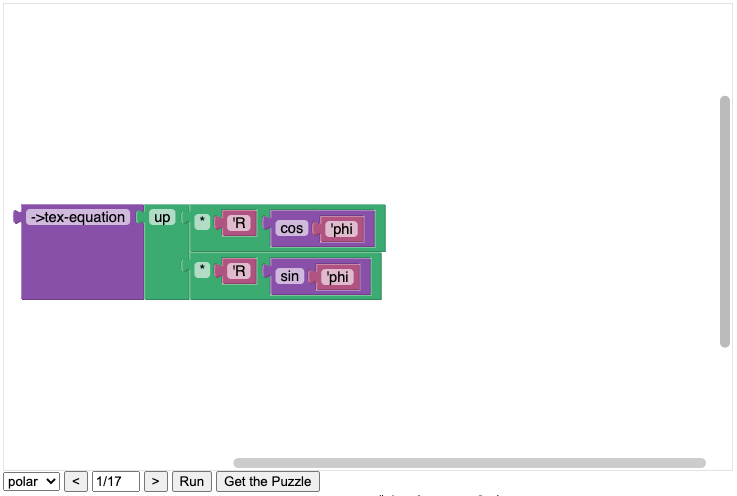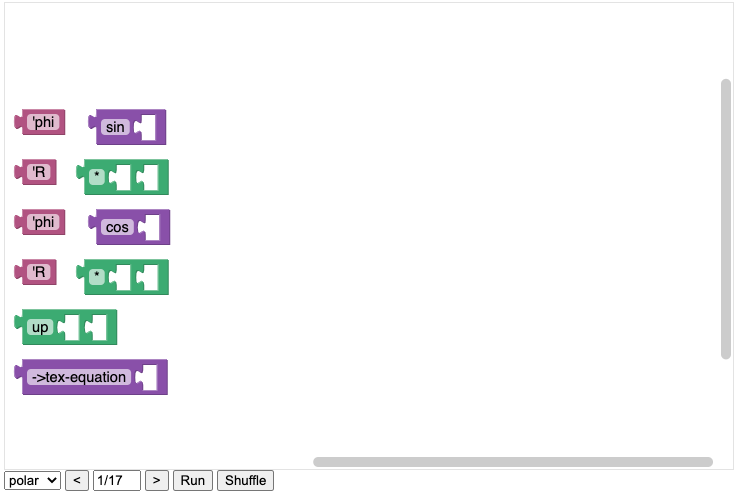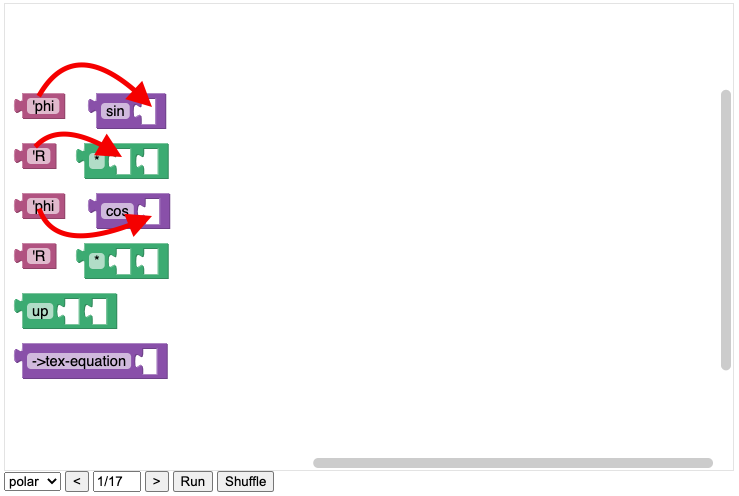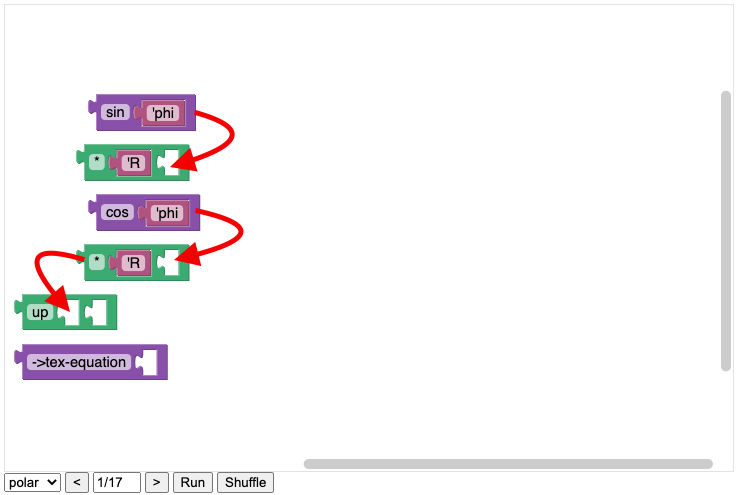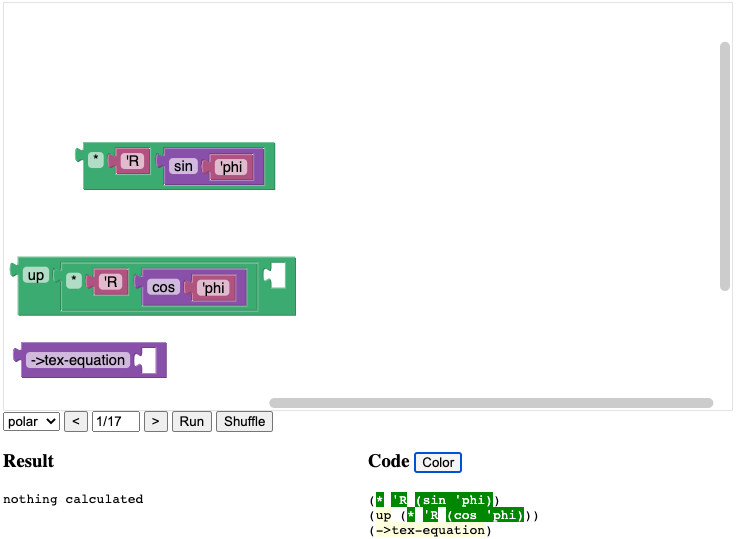- Visual programming for STEM students at university level
- Stop to cradle notes on silent paper, solve graphical puzzles in the browser
- Over 100 puzzles represent executable code in algebra and physics
- Live coding for tutors without any need for experience in software development
- Doing science "in functions" becomes as easy as using a formula editor
- Get Wordle inspired feedback
- Load more puzzles from the web with the built in parser
- Create puzzels on your local machine
clj-tiles is a mixture of formula editor, Wordle and Scratch
External links: STEM, Scratch, Wordle, Mathlive formula editor
- Out of this documentation, being a conglomeration, write a journal article "Competence before Comprehension"
- Prepare a series of lectures on basic mathematical finance, showing the advantages of clj-tiles over the usual Excel spreadsheet approach
- Add as main calculation engine JAX + Python
- Contribute to the interdisciplinary field of cognitive science with a study to assess the efficacy of the lectures
External links: Cognitive Science, JAX, Python
If you like videos (I find text better), watch my presentation for the Visual Tools meeting and load the Visual Geometry tutorial to interactively follow along.
As an alternative introduction, look at the following picture which appears in clj-tiles for Visual Algebra.
You notice the Get the Puzzle button and press it.
This looks rather complicated, but you start to notice that the contents of the graphical blocks are the same as in the first picture. There is R, phi, sin and so on.
As a hint of how to proceed, we show (with arrows) the first steps to complete the puzzle.
After these first steps, you continue...
... and arrive at the following picture.
Interesting here is the Color button. It indicates that you are on the right track. It is modelled after Wordle. Can you finish the puzzle now? After all, you can look up the solution in the first picture above.
When completing a puzzle, the colouring of the generated code changes gradually. As soon as an expression matches, it turns green. Shown below are the according stages of the above example.
The domain of the above "Visual Algebra" tutorial is known to any high school student: conversion of polar coordinates (R and phi) to the usual rectangular ones, a formula typed into math editors of word processors all over the world.
But this is just a start. By completing all the puzzle-workspaces of this visual tutorial, a physics students in the 3rd semester can learn Classical Mechanics. Indeed they first get competent by solving the puzzles, maybe just learning the solutions by heart. Then, they will gain a much deeper comprehension when reading more carefully the book "Structure and Interpretation of Classical Mechanics".
Admittedly, the learning curve of that book is very steep. That is way I created a somewhat simpler physics tutorial with my own descriptions and hand-crafted puzzles in the tutorial Visual Motion.
This set of tutorials also contains the simplest chapter of all: completing Bob Dylan lyrics. That chapter also shows that the scope of clj-tiles might be broader than STEM. It was also the chapter I opened my talk with at the reClojure conference 2021 (youtube playlist).
External link: Structure and Interpretation of Classical Mechanics
clj-tiles is suited not only for learning but especially also teaching STEM. Live coding in the lecture room is made easy. Instructors do not need to have any software development skills, they just solve puzzles in front of the audience. Typos like in text-editor based live coding are thus avoided. Students can follow along in real-time on their own computers.
In the literature this method of learning and teaching is known as Parsons puzzle. With this, teaching itself becomes the subject of interdisciplinary studies in cognitive science. Questionnaires and control groups can be used to assess the efficacy of the method.
I tried to more explain this topic in the context of teaching advanced physics classes in an early preliminary draft for a paper on visual programming.
External link: Parsons puzzle
The implementation of the clj-tiles app is based on Clojure, a functional programming language from the LISP family. Indeed, many tutorials in clj-tiles are for learning this great language, starting with  . More advanced tutorials make use of the splendid Emmy Computer Algebra System.
. More advanced tutorials make use of the splendid Emmy Computer Algebra System.
The blocks of clj-tiles are meant to exclusively represent a functional-style notation. This is the all important difference between clj-tiles and the visual building tools Scratch and BlockPy, which are multi-paradigm.
As opposed to the very popular Python, Clojure is a niche language. Nevertheless, I tried to show, in comparison to common Python syntax, the advantages of its functional notation for STEM in a preprint article on how to design a functional interface.
However, recently there has been introduced a Python library which rapidly gains popularity and embraces functional notation, namely JAX: "the kinds of program transformations that JAX enables are much more feasible in functional-style programs". Casually said, JAX is Clojure bolted onto Python, both are "Science in Functions".
JAX+Python opens up a fruitful future path for clj-tiles. It is perfectly feasible, via the Hy language, to generate JAX syntax out of the already existing block notation. In this way, STEM students are immediately introduced to functional notation via clj-tiles whilst being able to switch into any professional Python development environment as clj-tiles is not meant for building programs but for understanding already existing code.
External link: Clojure, Emmy Computer Algebra System, BlockPy, functional-style JAX, Hy
In interactive experiences, points, badges and achievements are not attributes of true gamification but rather hollow structures. Rather important are content and its exploration and immediate feedback. The Wordle colouring and the hand-crafted puzzles mentioned above are testimony to this.
In this respect, another feature of clj-tiles is that the user first needs to solve a puzzle before getting the solution to the next one. Yet another way of awarding the user with content is the Shuffle button which makes solving much harder. There is also a cheat mode which in principle can be deduced from the in-game descriptions (and spoilt in the "Visual Tools" video above).
Also, inspired by talking chess computers, poetry apps, text- and point-and-click adventure games, I experimented with the "inspect" feature of clj-tiles to create an even more interactive experience. The according workspace appears in the tutorial Visual Interaction.

As this workspace is not yet self explanatory, I provide a walkthrough video.
External links: Awesome game design talk by Brian Moriarty, Endure interactive fiction by Emily Short, Detectiveland point-and-click text adventure by Robin Johnson, Poems by Heart not Inkle's but my own attempt.
There is a simple way to create own puzzles. Open the dedicated parser by right clicking on a white space. Paste the following code into the text field:
(sort [2 1 3])
Press the Insert and then the Run button. As can be seen in the picture below, the result of the computer program you just created and executed results in sorted numbers:
If you like to see a more involved example of web-programming, launch the rocket found in the book "How to Design Programs" with Visual Web programming.
While by pressing the Run button a whole workspace is executed, the user can inspect individual blocks by right clicking on them. Then, the result of the expression represented by the respective block is displayed. Indicated along with the result is the type of the data.
Also, you can load new tutorials from the web. Open the parser and select a tutorial in the drop down menu: a URL appears in the text field.
External link: How to Design Programs
The tutorials on the web which can be loaded via the parser are simple text files containing code. Everyone can create such tutorials and load them from the local laptop.
More information on local tutorials, the parser and visual representations of code can be found in this document.
GPL v3 Copyright © 2021 Markus Kloimwieder
